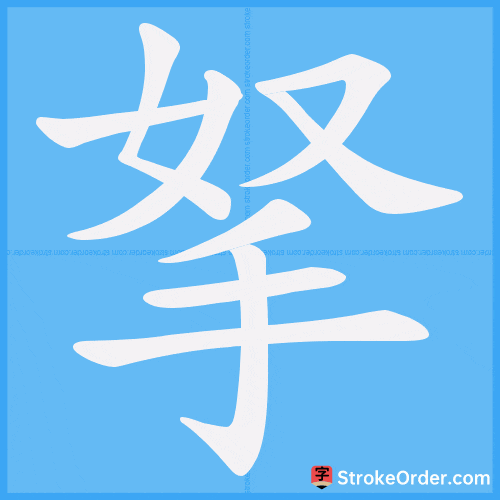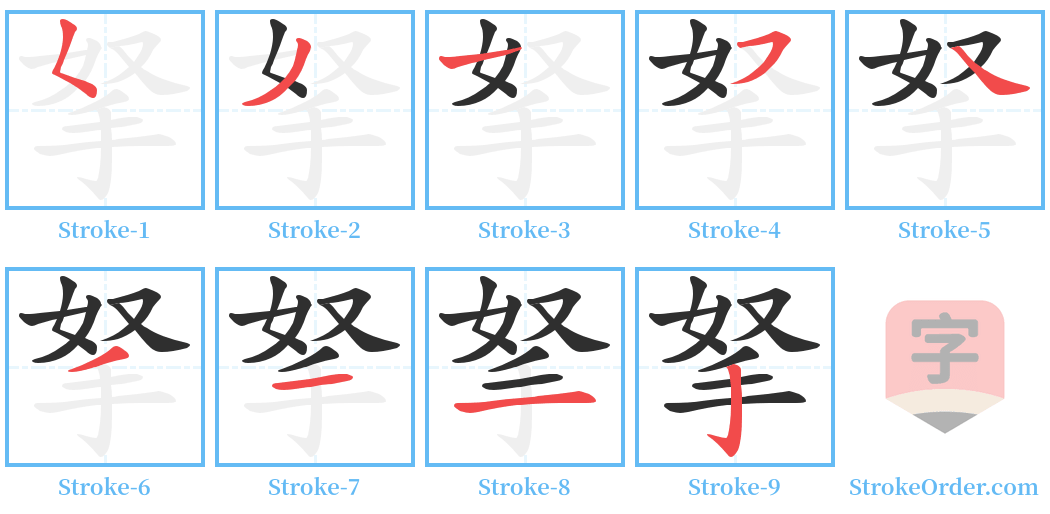拏 Stroke Order
Animated Stroke Order of 拏

Stroke Order Diagrams for 拏

Information of 拏
Pinyin
ná
Radical
手
Strokes
9 strokes
Usage
★★
Definition
拏 [ná]
1. Same as "拿" (take).
同“拿”。
2. To draw or pull.
牵引。
---
拏 [ná] (verb)
1. To hold or take; to grasp. Later written as "拿" ([En.] take).
持拿;执取。后作“拿” ([En.] take)
2. To fight or struggle. ([En.] fight)
搏斗 ([En.] fight)
3. Same as "拿". To catch or seize. ([En.] catch)
同“拿”。捉拿;捕捉 ([En.] catch)
4. To implicate; to connect. ([En.] draw; connect)
牵连;连结 ([En.] draw;connect)
引 (References):
1. "说文": 拏, 持也。从手,奴声。
《说文》:拏,持也。从手,奴声。
2. "苍颉篇": 拏, 捽也。
《苍颉篇》:拏,捽也。
3. Li He’s "致酒行": Young hearts should grasp the clouds, who cares for the chilling solitude?
李贺《致酒行》:少年心事当拏云,谁念幽寒坐呜呃。
4. Meng Hanyu's "魔合罗": There are documents to be submitted, let me take responsibility for the signing.
孟汉卿《魔合罗》:有合佥押的文书,拏来我佥押。
示例 (Examples):
- 拏事 (to manage affairs; to have power)
- 拏空 (to reach out into the void)
- 拏手 (to have a firm grasp on things; to be adept)
- 拏云 (metaphorically speaking, to have lofty ambitions and great abilities)
- 拏把 (to seize)
2. To fight or struggle. ([En.] fight)
搏斗 ([En.] fight)
引 (References):
1. Zhang Heng's "西京赋": The bear and tiger rise to fight.
张衡《西京赋》:熊虎升而拏攫。 注:“相搏持也。”
示例 (Examples):
- 拏战 (to engage in combat)
- 拏攫 (to struggle or fight)
- 拏斗 (to contend or battle)
3. Same as "拿". To catch or seize. ([En.] catch)
同“拿”。捉拿;捕捉 ([En.] catch)
引 (References):
1. "水浒传": The magistrate brought a group of captured neighbors for questioning.
《水浒传》:知县把一干拏到的邻舍当厅勘问。
示例 (Examples):
- 拏把 (to grasp)
- 拏究 (to arrest and investigate)
- 拏访 (to capture and interrogate)
- 拏获 (to capture)
- 拏人 (similar to a catcher or enforcer)
4. To implicate; to connect. ([En.] draw; connect)
牵连;连结 ([En.] draw; connect)
引 (References):
1. "后汉书·冯衍传": The looming disaster remains unresolved; the violence continues.
《后汉书·冯衍传》:祸拏未解,兵连不息。
示例 (Examples):
- 拏兵 (to call forth an army)
- 拏云攫石 (the ancient tree stands proudly, roots entwined with stone crevices)
---
音饶。古通【桡】。船桨。出处。
Sound: "ráo". Anciently interchangeable with "桡". Refers to a boat oar. Reference.
音饶。古通【桡】。船桨。出处《庄子-渔父》,版本存在差异,有写【拏】的,有写【挐】的。
Sound: "ráo". Anciently interchangeable with "桡". Refers to a boat oar. From "Zhuangzi - Fisherman", with variant writings using both "拏" and "挐".